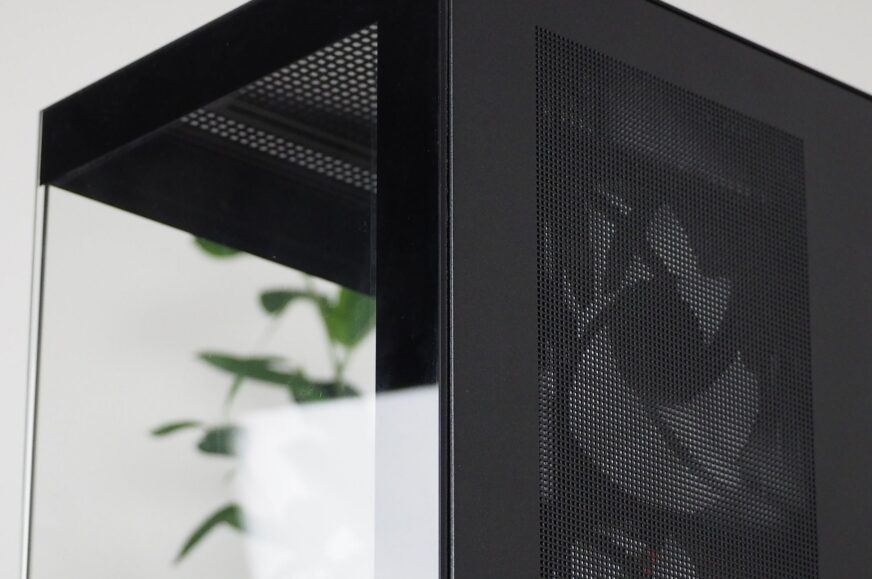Conclusion
Aquarium or terrarium? In short, a proper glass (panoramic?) case with a good view of the components. It is not only the appearance that is supposed to be “attractive”, but also the abundant options for cooling, or rather installation of liquid coolers. And reconfiguring the system fans can also make sense with the DeepCool CH780. We chart the differences in the comparison tests as well.
Conclusion
Despite the fact that the sample of cases for comparison is quite small (we couldn’t use a tall cooler as usual), the test results show one remarkable thing.The factory fan setup with “outtake” orientation is less efficient than if you switch the system cooling completely to “intake”.
With traditional layouts (three fans in front vs. three fans in the back/under the ceiling) this may not (and usually won’t) be the case, but the situation in the DeepCool CH780 is a bit specific. Namely, the fact that the fans are always quite far away from the motherboard, and when oriented to draw warm air away from the interior, they create less pressure in the area that needs to be cooled the most compared to the opposite situation. Pressure is also lost as the case shell is quite heavily perforated. This in turn is an advantage of the reverse orientation, where heat does not accumulate and, conversely, heated air can escape efficiently even if there is nothing “speeding” it up at the exhaust grille. It’s just a pity that there is no dust filter behind the side panel. Thus, when the fans are turned around in the factory position, faster dust pollution from the surroundings can be expected. Thus, more frequent maintenance will be required. However, the trio of fans can be removed from the side and placed, for example, under the ceiling or on the ground floor. They cannot be separated because of the shared frame.
On the other hand, it should also be noted that the case is primarily designed for liquid coolers and our situation (with the Noctua NH-L9x65 SE-AM4) does not reflect the expected scenario too much.
The build quality of the case is of a high standard. The extra thickness of the sheet metal ensures robustness of the entire structure. The top and side panels are snapped on with a tool-less latching mechanism, giving you quick access to all components. There are almost infinite options for experimenting with cooling, whether you want to use air or liquid. You can even fit 180 and 200 mm fans on the ground and ceiling. You can put up to three 360/420 mm radiators at a time. Connectivity isn’t lagging behind either, and you’ll be pleased with the ability to plug in up to five USB connectors, one of which is the faster Type-C.
Hardware installation went smoothly, apart from the difficulty with the shorter PCI Express riser. The removable panels on the sides, front, and top are a big help during the installation. This opens up the entire case and nothing gets in the way of installation. The tray which is protruding into the case interior creates a lot of room for cable management.
From the case as a whole, you can see that DeepCool went to great lengths in it’s design and execution. Everything from the design to the installation fits together and so I have no choice but to give the CH780 the highest “Top-notch” award.
English translation and edit by Jozef Dudáš
| DeepCool CH780 |
| + Solid build quality |
| + As many as nine positions for 120/140 mm fans... |
| + ... and the option to use four 180/200 mm fans |
| + Up to three positions for a 360/420 format radiator |
| + Fine dust filter on the bottom and top panels |
| + As many as five USB connectors (including a fast Type-C) |
| + Easy installation and cable management |
| - Does not support taller tower CPU coolers |
- Contents
- Exterior
- Interior
- Testing methodology
- CPU and GPU cooling tests
- Motherboard cooling tests
- SSD cooling tests
- Conclusion










That’s a much better fan rail design than most cases. Further improvement would require a design that only covers the corners of the fans.
For intake vs. exhaust, I’d imagine the reason why exhaust is worse is partly due to the open top. Without a radiator and with only the stock case fans in exhaust orientation, covering the top vents should result in more airflow over the motherboard area. This applies to the intake orientation too, but to a lesser extent since air is thrown towards the general direction of the components.
Thanks for the great review. This is a very nice case and I am excited to build in it.
My current plan is: AIO top exhaust, side block in take, bottom 3 fans intake.
This config provides too little exhaust vs intake. Because of this, I am considering alternatives described in configs 1 and 2.
https://ibb.co/RNtqzFx – config 3
https://ibb.co/xJRsJ3J – config 1
https://ibb.co/CQJrB0v – config 2
I’m leaning towards config 1 bc there’s actually slightly more intake as there’s 3x140mm + 1×120 vs 5x 120mm with aio interfering with 3.
Config 2 would be too close to negative air pressure, leading to dust build up inside case.
“The Deepcool CH780 impresses with its wide viewing angles and solid performance at the core, offering great value for users seeking quality sound and comfort. An excellent choice for those who prioritize both style and functionality in their gaming or multimedia setup.”